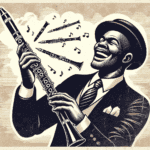The clarinet, a versatile and expressive woodwind instrument, has a rich history that dates back several centuries. Its evolution is marked by significant changes in design, technology, and playing techniques. Understanding the historical development of the clarinet can enhance our appreciation of its role in various musical genres and its continued popularity among musicians worldwide.
THE EARLY BEGINNINGS
THE CHALUMEAU: CLARINET'S ANCESTOR
- Origin: The clarinet's earliest predecessor is the chalumeau, a single-reed instrument used in Europe during the late 17th century.
- Design: It featured a cylindrical bore and a limited range, mainly used for playing simple melodies.
- Transition: The chalumeau's design laid the foundation for the development of the clarinet.
JOHANN CHRISTOPH DENNER: THE INNOVATOR
- Introduction of the Clarinet: Around 1700, German instrument maker Johann Christoph Denner improved the chalumeau by adding a register key, thus creating the first true clarinet.
- Impact: This modification extended the instrument's range and allowed for a richer, more versatile sound.
| Era | Instrument | Key Features |
|---|---|---|
| Late 17th Century | Chalumeau | Single-reed, cylindrical bore, limited range |
| Early 18th Century | First Clarinet | Added register key, extended range |
THE CLASSICAL PERIOD
REFINEMENTS AND STANDARDIZATION
- Key Mechanism: During the classical period, the clarinet underwent several refinements, including the addition of more keys to improve playability and intonation.
- Influence: Composers like Mozart began writing for the clarinet, showcasing its capabilities in orchestral and chamber music.
THE FIVE-KEY CLARINET
- Development: By the late 18th century, the five-key clarinet became standard, allowing for greater musical expression and technical possibilities.
- Popularization: This version of the clarinet gained widespread acceptance among musicians and composers.
THE ROMANTIC ERA
THE 13-KEY CLARINET
- Advancements: The early 19th century saw the development of the 13-key clarinet, which further enhanced the instrument's range and tonal flexibility.
- Composer Influence: The expanded capabilities of the clarinet inspired composers like Brahms and Weber to write more complex and demanding pieces for the instrument.
B FLAT AND E FLAT CLARINETS
- Variants: The introduction of the B flat and E flat clarinets provided musicians with options for different tonal qualities and playing contexts.
- Adoption: These variants became staples in both orchestral and band settings, further solidifying the clarinet's role in various musical traditions.
Clarinet Evolution Timeline
- Late 17th Century: Chalumeau
- c. 1700: First true clarinet by Johann Christoph Denner
- Late 18th Century: Five-key clarinet
- Early 19th Century: 13-key clarinet
- Mid-19th Century: Introduction of the Boehm system
- 20th Century to Present: Modern clarinet with ongoing refinements
THE MODERN CLARINET
THE BOEHM SYSTEM
- Innovation: In the mid-19th century, Hyacinthe Klosé and Auguste Buffet introduced the Boehm system, revolutionizing clarinet design.
- Features: The Boehm system included a new key arrangement and fingerings, significantly improving technical facility and intonation.
- Legacy: The Boehm system remains the standard for modern clarinets, with minor modifications and improvements over the years.
CONTEMPORARY DEVELOPMENTS
- Materials: Advances in materials, such as synthetic reeds and composite bodies, have enhanced the durability and consistency of modern clarinets.
- Technology: Modern manufacturing techniques ensure precise and reliable instruments, catering to the needs of both professional and amateur musicians.
THE CLARINET IN VARIOUS GENRES
CLASSICAL MUSIC
- Role: The clarinet continues to play a crucial role in orchestral and chamber music, with a vast repertoire spanning from the classical period to contemporary works.
- Composers: Works by Mozart, Brahms, and Stravinsky highlight the clarinet's expressive range and technical prowess.
JAZZ
- Influence: The clarinet has been a prominent instrument in jazz since the early 20th century, with legendary players like Benny Goodman and Artie Shaw pushing its boundaries.
- Techniques: Jazz clarinetists often employ unique techniques, such as glissando and growling, to create distinctive sounds and styles.
FOLK AND WORLD MUSIC
- Versatility: The clarinet's adaptability makes it popular in various folk and world music traditions, from Eastern European klezmer to Middle Eastern music.
- Cultural Significance: In these genres, the clarinet often serves as a primary melodic instrument, bringing cultural and historical richness to performances.
THE CLARINET COMMUNITY
LEARNING AND TEACHING
- Education: Clarinets are widely taught in schools and universities, with a focus on both classical and contemporary techniques.
- Resources: Numerous online resources, including tutorials and masterclasses, are available for aspiring clarinetists to improve their skills.
MAINTENANCE AND REPAIR
- Care: Regular maintenance, such as cleaning and reed replacement, is essential for optimal performance.
- Repairs: Professional repair services ensure that clarinets remain in top playing condition, addressing issues like pad replacement and key adjustments.
COLLECTING AND VALUING
- Antique Clarinets: Collectors often seek historical clarinets, valuing their craftsmanship and historical significance.
- Appraisal: Expert appraisal services help determine the value of vintage and rare clarinets, providing insight into their historical context and market worth.
The clarinet's evolution from the chalumeau to the modern instrument we know today is a fascinating journey of innovation and musical expression. Whether you're a player, teacher, or enthusiast, understanding the clarinet's rich history enhances your appreciation for this remarkable instrument. As you continue to explore the world of clarinets, remember the legacy of craftsmanship and artistry that has shaped its development over centuries.







